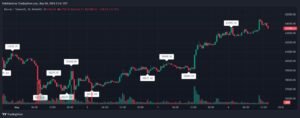Bitcoin, the pioneering cryptocurrency, has once again captured the attention of investors and enthusiasts alike with its recent surge in price, climbing to $63,532.85, marking a 3.19% increase over the course of a day. This significant movement in the cryptocurrency market comes in the wake of several notable events, including the US Federal Reserve’s announcement of a rate pause and the release of the Non-Farm Payrolls (NFP) data for April 2024 by the US Bureau of Labor Statistics. In this detailed analysis, we delve into the factors behind Bitcoin’s recent price surge, exploring the implications of economic indicators such as the NFP report on cryptocurrency markets and investor sentiment.

Bitcoin’s Post-Halving Sell-Off and Market Recovery:
Following the much-anticipated Bitcoin halving event, which occurred in May 2020, the cryptocurrency experienced a period of sell-off as market participants adjusted to the reduced block rewards. However, this downward trend has shown signs of stalling in recent weeks, particularly after the US Federal Reserve signaled a pause in its rate hikes. The announcement of a halt in interest rate increases provided a sense of relief to investors and paved the way for a mild recovery phase in the cryptocurrency market.
Non-Farm Payrolls Data and Its Impact on Bitcoin Price:
One of the key events that influenced Bitcoin’s recent price surge is the release of the Non-Farm Payrolls (NFP) data for April 2024. The NFP report, published by the US Bureau of Labor Statistics, provides crucial insights into the health of the US labor market by tracking the number of jobs added or lost in non-agricultural sectors. In April 2024, the US economy added 175,000 non-farm jobs, falling short of market expectations by 28% and signaling a month-on-month decline of 140,000 jobs.
The significance of the NFP report lies in its implications for monetary policy and economic growth. A decline in non-farm jobs typically indicates a contracting economy, prompting policymakers to consider expansionary measures such as interest rate cuts to stimulate economic activity. The underwhelming NFP data for April 2024 raised expectations of a potential rate cut by the US Federal Reserve in the near future, leading to a bullish sentiment in the cryptocurrency markets.
Market Reaction to the NFP Report:
The initial reaction of the cryptocurrency markets to the release of the NFP report on Friday echoed this bullish stance. Within hours of the report’s publication, Bitcoin’s price surged by 4%, climbing from $59,000 to a daily peak of $61,770. This rapid price movement suggests that investors interpreted the NFP data as a signal of potential monetary stimulus from the Federal Reserve, driving demand for risk assets like Bitcoin.
The Relationship Between Rate Cuts and Bitcoin Demand:
Historically, rate cuts by central banks have been associated with increased demand for risk assets such as Bitcoin. Lowering interest rates reduces the cost of borrowing and decreases returns on traditional fixed-income assets, making alternative investments like cryptocurrencies more appealing to investors seeking higher yields. As speculation grows regarding the possibility of a rate cut in the second quarter of the year, investors may be inclined to front-run the potential upside from such a policy shift, leading to increased buying activity in the Bitcoin market.
Looking Ahead: Implications for Bitcoin Investors:
As the next Federal Reserve meeting approaches in June, the cryptocurrency market is likely to remain sensitive to developments in economic indicators and monetary policy announcements. A contraction in the jobs market, coupled with other macroeconomic factors, could further increase the likelihood of a rate cut by the Federal Reserve, potentially driving continued upward momentum in Bitcoin prices. However, investors should remain vigilant and consider the inherent volatility of the cryptocurrency market when making investment decisions.
Bitcoin’s recent price surge to $63,500 reflects a confluence of factors, including the US Federal Reserve’s rate pause and the release of the Non-Farm Payrolls data for April 2024. The underwhelming job growth figures have heightened expectations of a potential rate cut by the Federal Reserve, leading to increased demand for risk assets like Bitcoin. As investors anticipate further monetary stimulus measures, the cryptocurrency market is poised for continued volatility and price appreciation in the coming months. However, it is essential for investors to exercise caution and conduct thorough research before participating in the dynamic and rapidly evolving cryptocurrency landscape.
ALSO READ: Cryptocurrency Gainers: Bonk, Core, Floki, Shib, and Pepe




